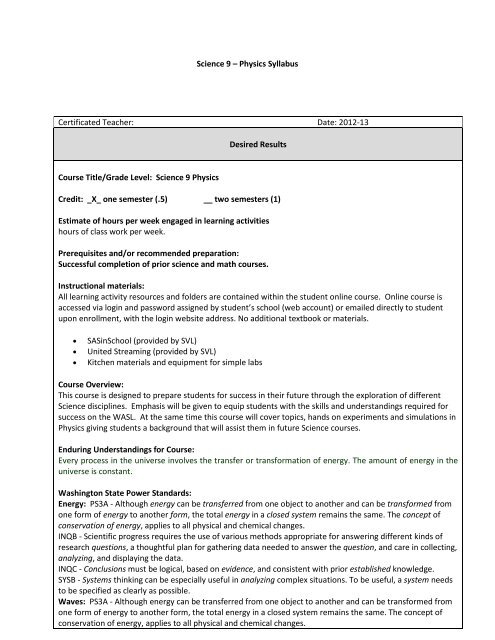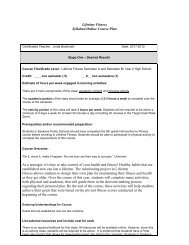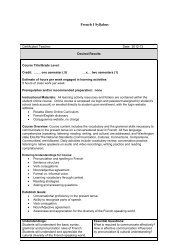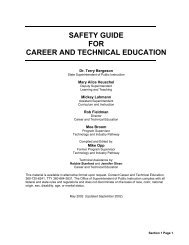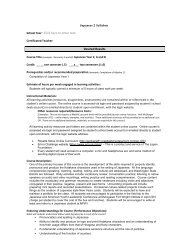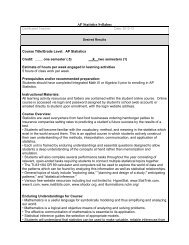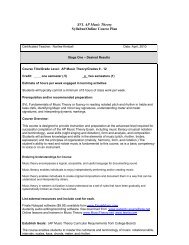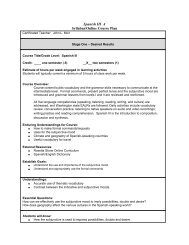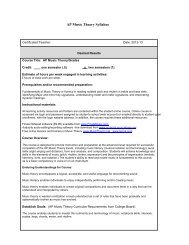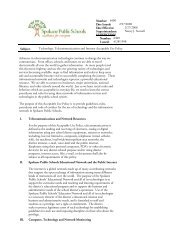Science 9A Physics Syllabus.pdf - Spokane Public Schools
Science 9A Physics Syllabus.pdf - Spokane Public Schools
Science 9A Physics Syllabus.pdf - Spokane Public Schools
You also want an ePaper? Increase the reach of your titles
YUMPU automatically turns print PDFs into web optimized ePapers that Google loves.
<strong>Science</strong> 9 – <strong>Physics</strong> <strong>Syllabus</strong><br />
Certificated Teacher: Date: 2012-13<br />
Desired Results<br />
Course Title/Grade Level: <strong>Science</strong> 9 <strong>Physics</strong><br />
Credit: _X_ one semester (.5) __ two semesters (1)<br />
Estimate of hours per week engaged in learning activities<br />
hours of class work per week.<br />
Prerequisites and/or recommended preparation:<br />
Successful completion of prior science and math courses.<br />
Instructional materials:<br />
All learning activity resources and folders are contained within the student online course. Online course is<br />
accessed via login and password assigned by student’s school (web account) or emailed directly to student<br />
upon enrollment, with the login website address. No additional textbook or materials.<br />
• SASinSchool (provided by SVL)<br />
• United Streaming (provided by SVL)<br />
• Kitchen materials and equipment for simple labs<br />
Course Overview:<br />
This course is designed to prepare students for success in their future through the exploration of different<br />
<strong>Science</strong> disciplines. Emphasis will be given to equip students with the skills and understandings required for<br />
success on the WASL. At the same time this course will cover topics, hands on experiments and simulations in<br />
<strong>Physics</strong> giving students a background that will assist them in future <strong>Science</strong> courses.<br />
Enduring Understandings for Course:<br />
Every process in the universe involves the transfer or transformation of energy. The amount of energy in the<br />
universe is constant.<br />
Washington State Power Standards:<br />
Energy: PS3A - Although energy can be transferred from one object to another and can be transformed from<br />
one form of energy to another form, the total energy in a closed system remains the same. The concept of<br />
conservation of energy, applies to all physical and chemical changes.<br />
INQB - Scientific progress requires the use of various methods appropriate for answering different kinds of<br />
research questions, a thoughtful plan for gathering data needed to answer the question, and care in collecting,<br />
analyzing, and displaying the data.<br />
INQC - Conclusions must be logical, based on evidence, and consistent with prior established knowledge.<br />
SYSB - Systems thinking can be especially useful in analyzing complex situations. To be useful, a system needs<br />
to be specified as clearly as possible.<br />
Waves: PS3A - Although energy can be transferred from one object to another and can be transformed from<br />
one form of energy to another form, the total energy in a closed system remains the same. The concept of<br />
conservation of energy, applies to all physical and chemical changes.
INQB - Scientific progress requires the use of various methods appropriate for answering different kinds of<br />
research questions, a thoughtful plan for gathering data needed to answer the question, and care in<br />
collecting, analyzing, and displaying the data.<br />
INQC - Conclusions must be logical, based on evidence, and consistent with prior established knowledge.<br />
SYSB - Systems thinking can be especially useful in analyzing complex situations. To be useful, a system needs<br />
to be specified as clearly as possible.<br />
Motion: PS1C - An object at rest will remain at rest unless acted on by an unbalanced force. An object in<br />
motion at constant velocity will continue at the same velocity unless acted on by an unbalanced force.<br />
(Newton’s First Law of Motion, the Law of Inertia)<br />
INQB - Scientific progress requires the use of various methods appropriate for answering different kinds of<br />
research questions, a thoughtful plan for gathering data needed to answer the question, and care in collecting,<br />
analyzing, and displaying the data.<br />
INQC - Conclusions must be logical, based on evidence, and consistent with prior established knowledge.<br />
SYSB - Systems thinking can be especially useful in analyzing complex situations. To be useful, a system needs<br />
to be specified as clearly as possible.<br />
Forces: PS1D – A net force will cause an object to accelerate or change direction. A less massive object will<br />
speed up more quickly than a more massive object subjected to the same force. (Newton’s Second Law of<br />
Motion, F=ma)<br />
INQB - Scientific progress requires the use of various methods appropriate for answering different kinds of<br />
research questions, a thoughtful plan for gathering data needed to answer the question, and care in collecting,<br />
analyzing, and displaying the data.<br />
INQC - Conclusions must be logical, based on evidence, and consistent with prior established knowledge.<br />
SYSB - Systems thinking can be especially useful in analyzing complex situations. To be useful, a system needs<br />
to be specified as clearly as possible.<br />
Work: PS3A - Although energy can be transferred from one object to another and can be transformed from<br />
one form of energy to another form, the total energy in a closed system remains the same. The concept of<br />
conservation of energy, applies to all physical and chemical changes.<br />
INQB - Scientific progress requires the use of various methods appropriate for answering different kinds of<br />
research questions, a thoughtful plan for gathering data needed to answer the question, and care in collecting,<br />
analyzing, and displaying the data.<br />
INQC - Conclusions must be logical, based on evidence, and consistent with prior established knowledge.<br />
SYSB - Systems thinking can be especially useful in analyzing complex situations. To be useful, a system needs<br />
to be specified as clearly as possible.<br />
APPC - Choosing the best solution involves comparing alternatives with respect to criteria and constraints,<br />
then building and testing a model or other representation of the final design.<br />
APPD - The ability to solve problems is greatly enhanced by use of mathematics and information technologies.<br />
Grading Scale:<br />
100-90 A<br />
89-80 B<br />
79-70 C<br />
69-65 D<br />
64-Below F<br />
Students will know and be able to:<br />
Understand sound waves, water waves, and light waves using wave properties, including amplitude,<br />
wavelength, and speed. Understand wave behaviors, including reflection, refraction, transmission, and
absorption<br />
Understand that energy is a property of matter, objects, and systems and comes in many forms (i.e. heat<br />
(thermal) energy, sound energy, light energy, electrical energy, kinetic energy, potential energy, and chemical<br />
energy).<br />
Understand how components, structures, organizations, and interconnections describe systems.<br />
Analyze how systems function, including the inputs, outputs, transfers, transformations, and feedback of a<br />
system and its subsystems<br />
Understand how various factors affect energy transfers and that energy can be transformed from one form of<br />
energy to another<br />
Develop the knowledge and skills necessary to do scientific inquiry.<br />
Understand the nature of scientific inquiry<br />
Understand the positions, relative speeds, and changes in speed of objects.<br />
Understand how interactions within and among systems cause changes in matter and energy.<br />
Understand factors that affect the strength and direction of forces.<br />
Understand how balanced and unbalanced forces can change the motion of objects.<br />
Evidence of Assessment<br />
What evidence will be collected to determine whether or not the understandings have been developed, the<br />
knowledge and skill attained, and the state standards met [Anchor the work in performance tasks that<br />
involve application, supplemented as needed by prompted work, quizzes, observations, etc.]<br />
Performance Tasks:<br />
Project Based Learning Lessons<br />
Interactive Web based learning<br />
Hands on lab experiences<br />
Discussion Boards<br />
Academic Integrity:<br />
It is the responsibility of the student to uphold the highest in academic integrity. Students in this course will<br />
be expected to comply with the official <strong>Spokane</strong> District 81 Policy regarding Academic Integrity. It is the<br />
assumption of the instructor that all work is done by the student.<br />
District Computer/Network Usage:<br />
Careful and ethical use of computing resources is the responsibility of every user. Students will be held to a<br />
stand of accountability for how they use computers. The official District Acceptable Use Policy is found here<br />
(PDF).<br />
Other Evidence:<br />
Formative Assessments<br />
Summative Assessments<br />
Make-up Exam Policy<br />
Although most timelines for work in this course will be flexible, there will be deadlines for some items. When<br />
an assignment or test is due by a certain time, there may be extenuating circumstances that will require an<br />
extension. Such extensions must be requested in writing. Make-up exams and assignments need to be<br />
arranged through communication between the student and teacher.
Types of Learning Activities<br />
Learning Activities:<br />
Learning activities will be provided in such a way to target all types of learners. Instruction will be given in a<br />
variety of formats including readings, video, and powerpoint presentations. Students will have opportunities<br />
to show their learning in many ways such as model building, research projects, lab activities, and discussion<br />
boards. The nature of the course allows students to have flexibility in their learning.<br />
Direct Instruction<br />
__X__Structured<br />
Overview<br />
_X___Mini<br />
presentation<br />
__X__Drill &<br />
Practice<br />
____Demonstrations<br />
____Other (List)<br />
Indirect<br />
Instruction<br />
___X_Problembased<br />
___Case Studies<br />
___X_Inquiry<br />
_X___Reflective<br />
Practice<br />
_X___Project<br />
_X___Paper<br />
__X__Concept<br />
Mapping<br />
____Other (List)<br />
Experiential<br />
Learning<br />
____ Virt. Field<br />
Trip<br />
__X__Experiments<br />
__X__Simulations<br />
__X__Games<br />
____Field Observ.<br />
___Role-playing<br />
_X___Model Bldg.<br />
____Surveys<br />
____Other (List)<br />
Independent<br />
Study<br />
_X___Essays<br />
__X_Self-paced<br />
computer<br />
____Journals<br />
____Learning Logs<br />
__X__Reports<br />
__X__Directed<br />
Study<br />
__X__Research<br />
Projects<br />
____Other (List)<br />
Interactive<br />
Instruction<br />
_X___Discussion<br />
____Debates<br />
___Role Playing<br />
____Panels<br />
____Peer Partner<br />
Learning<br />
____Project team<br />
____Laboratory<br />
Groups<br />
__X__Think, Pair,<br />
Share<br />
Learning Activities:<br />
____Cooperative<br />
Learning<br />
____Tutorial Groups<br />
____Interviewing<br />
__X__Conferencing<br />
____Other (List)<br />
1 st Semester <strong>Science</strong> 9 <strong>Physics</strong><br />
Week(s) Units Assignments<br />
1 Intro Unit • 0.1 Introduction Blog<br />
2-5<br />
Unit 1 – Energy<br />
In this unit you will learn to identify various types of<br />
energy and describe a situation in which energy is<br />
transferred from one place to another and explain how<br />
energy is conserved. You will also be able to describe a<br />
situation in which energy is transformed from one form<br />
to another and explain how energy is conserved.<br />
• 1.1 Energy Pre-quiz<br />
• 1.2 Mentos and Soda<br />
• 1.3 What is Energy<br />
• 1.4 Energy Concept Map<br />
• 1.5 Energy Source Research<br />
Project<br />
• 1.6 Bounce<br />
• 1.7 Energy Game Show<br />
• 1.8 Energy Assessment
6-8<br />
9-11<br />
12-14<br />
Unit 2 – Sound and Electromagnetic Waves<br />
In this unit you will learn about different types of waves<br />
and how waves are mechanisms for transferring energy.<br />
You will also learn about the characteristics of waves<br />
and how to identify the frequency, wavelength,<br />
amplitude, and speed of different types of waves. The<br />
electromagnetic spectrum will also be studied. At the<br />
completion of this unit you will be able to illustrate the<br />
electromagnetic spectrum with a labeled diagram,<br />
showing how regions of the spectrum differ regarding<br />
wavelength, frequency, and energy, and how they are<br />
used.<br />
Unit 3 – Motion<br />
In this unit you will learn to calculate average velocity of<br />
a moving object, given the object’s change in position.<br />
You will also be able to explain how two objects moving<br />
at the same speed can have different velocities. With<br />
this knowledge you will be able to compare motion of<br />
an object acted on by balanced forces with the motion<br />
of an object acted on by unbalanced forces.<br />
Unit 4 – Forces<br />
In this unit you will learn about how a net force will<br />
cause an object to accelerate or change direction. A less<br />
massive object will speed up more quickly than a more<br />
massive object subjected to the same force. (Newton’s<br />
Second Law of Motion, F=ma). You will also learn about<br />
the types of forces as well as balanced and unbalanced<br />
forces.<br />
• 2.1 Waves Pre-quiz<br />
• 2.2 Discussion Board<br />
Assignment<br />
• 2.3 SAS - Wave Properties<br />
Interactivity #1200<br />
• 2.4 The Wave Equation<br />
• 2.5 The Soundry Activity<br />
• 2.6 A Sound Assessment<br />
• 2.7 NOVA Online: A Self-<br />
Guided Tour of the<br />
Electromagnetic Spectrum<br />
• 2.8 Wave Assessment<br />
• 3.1 Motion Pre-Quiz<br />
• 3.2 Motion Video<br />
• 3.3 Inertia Demo<br />
• 3.4 Position Vs. Time<br />
• 3.5 <strong>Physics</strong> 500<br />
• 3.6 SAS Interactivity #1198<br />
• 3.7 Bicycle vs. Teacher Race<br />
• 3.8 Motion Assessment I<br />
• 3.9 Motion Assessment II<br />
• 4.1 Forces Pre-quiz<br />
• 4.2 SAS Force Diagrams<br />
Lesson #44<br />
• 4.3 Force Interactions Lab<br />
• 4.4 Newton’s Laws of<br />
Motion Video<br />
• 4.5 Force Diagrams<br />
• 4.6 Force Assessment I<br />
• 4.7 Force Assessment II<br />
15-17<br />
Unit 5 - Energy, Work, & Simple Machines<br />
In this unit you will learn about Force and Energy and<br />
how the total energy in a closed system is conserved.<br />
You will also investigate how work is a measure of<br />
energy transferred to a system. We will then investigate<br />
the concept of simple machines.<br />
• 5.1 Work Pre-Quiz<br />
• 5.2 SAS Cookie Lesson #78<br />
• 5.3 Making the Grade<br />
Investigation<br />
• 5.4 It’s Simple – SAS Lesson<br />
#451<br />
• 5.5 Levers Investigation<br />
• 5.6 Review<br />
• 5.7 Assessment<br />
Adapted from Understanding by Design Template available online and the Understanding by Design: Professional Development Workbook.<br />
References:<br />
Wiggins, G., & McTighe, J. (n.d.). Understanding by Design Exchange. Retrieved November 2, 2004 from http://www.ubdexchange.org/<br />
Wiggins, G., & McTighe, J. (2004). Understanding by design: Professional development workbook. Alexandria, VA: Association for Supervision and Curriculum<br />
Development.)


